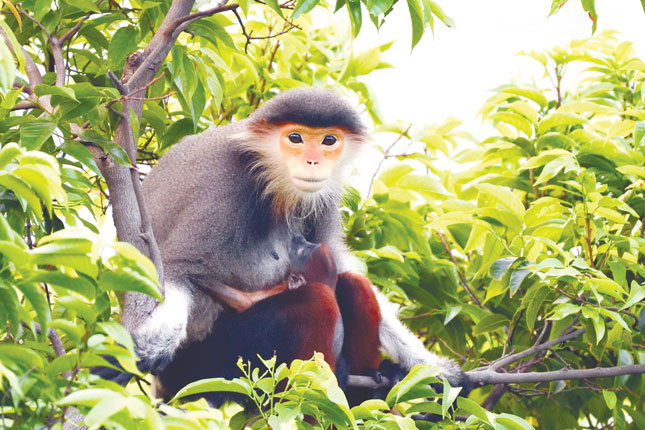More actions needed to protect red-shanked douc langurs in Da Nang
The 60km2 Son Tra Peninsula is considered a precious natural gift and a ‘green lung’ for both Da Nang and Quang Nam Province's Hoi An City. It also plays a vital role as a wind barrier to protect Da Nang during the stormy season.
 |
| A red-shanked douc langur seen on the Son Tra Peninsula |
The peninsula boasts a variety of rare plant and animal species. It is now home to 287 wild animals and 106 birds in different types. 15 of them are rare and precious species, including red-shanked douc langurs which account for 83% of the world total of this primate species.
According to the latest statistics released by the Da Nang Union of the Science and Technology Associations and the city-based GreenViet, a non-profit organisation working to conserve important ecosystems and endangered species in Central Viet Nam and Central Highlands, the Son Tra Peninsula is now home to a combined total of around 1,335 red-shanked douc langurs, divided into 237 troops, and their natural habitat covers a total area of 30km2 on the peninsula.
This animal was chosen as Da Nang’s official mascot for the APEC (Asia-Pacific Economic Cooperation) Economic Leaders’ Week in November 2017, and it has recently become a new symbol of Da Nang.
Numerous meaningful activities have been carried out in Da Nang over recent years to raise public awareness about preserving and promoting the sustainable development of the Son Tra Natural Conservation Area in an effort to protect the ‘Queen’ of the primate species.
In addition, Da Nang has cooperated with domestic and foreign organisations to conduct scientific research on the red-shanked douc langurs. Da Nang authorities have made plans for developing ecotourism on the peninsula to ensure both sustainable tourism development, and protection of the langurs.
However, the most worrying issue facing our city today is that Da Nang people and tourists often feed monkeys on the Son Tra Peninsula, which has resulted in some consequences, including the primates getting used to being fed rather than finding food on their own in the jungle.
Most recently, a herd of wild monkeys have been frequently spotted to gather on Hoang Sa Street to scavenge for food.
The monkeys are not afraid of humans. They are often seen scavenging in dumping sites for leftover food, or running after visitors and snatching their bags.
In fact, feeding monkeys creates many negative effects to both animals and humans.
The habit has led to the monkeys’ decreased ability of seeking food in nature and increased their dependence on people to fill their stomach, which is not really good for their digestive system.
This worrying situation only affects the living habits of monkeys, while those of red-shanked douc langurs have yet to be affected. However, it is also necessary for the city to take timely and effective measures to prevent red-shanked douc langurs from the similar situation.
According to scientists, red-shanked douc langurs on the Son Tra Peninsula often forage at lower altitudes of 200m, and their main food are figs, banyan leaves and many other leaves, but they like figs the most.
With this feature, Da Nang can plant more fig trees on the peninsula in a bid to create a more abundant food source for this rare species, which will help to strictly protect the existing number of primates, and keep them disease free.
By THAI MY - Translated by M.D